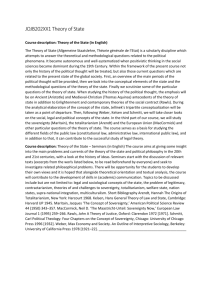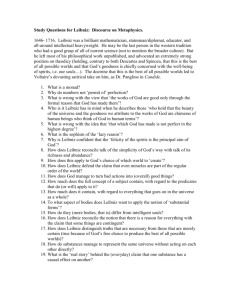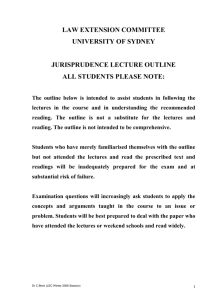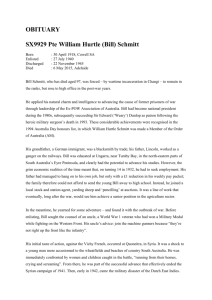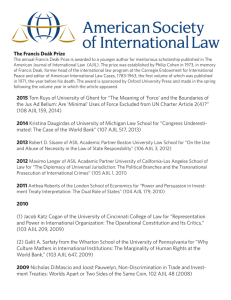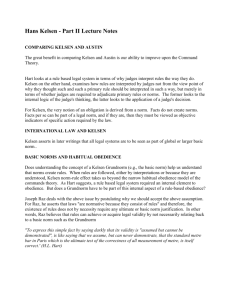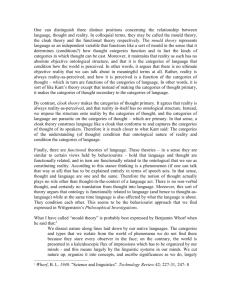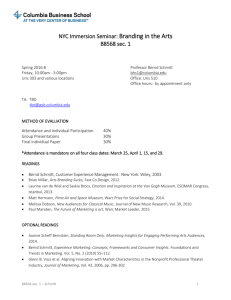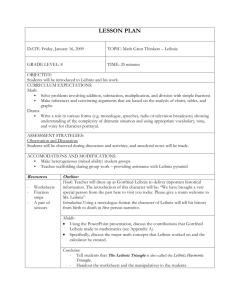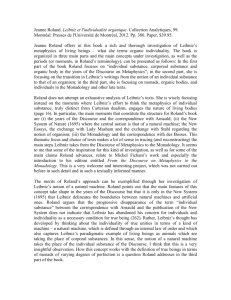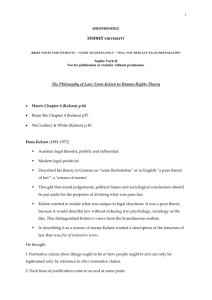Human Rights and World Public Order
advertisement
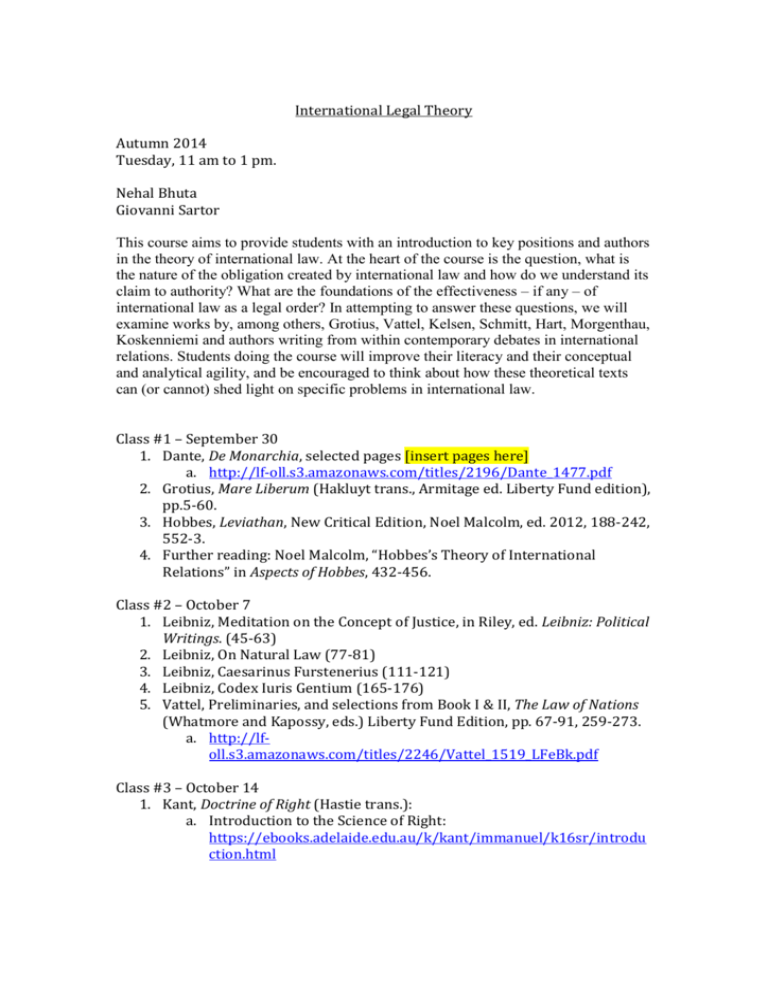
International Legal Theory Autumn 2014 Tuesday, 11 am to 1 pm. Nehal Bhuta Giovanni Sartor This course aims to provide students with an introduction to key positions and authors in the theory of international law. At the heart of the course is the question, what is the nature of the obligation created by international law and how do we understand its claim to authority? What are the foundations of the effectiveness – if any – of international law as a legal order? In attempting to answer these questions, we will examine works by, among others, Grotius, Vattel, Kelsen, Schmitt, Hart, Morgenthau, Koskenniemi and authors writing from within contemporary debates in international relations. Students doing the course will improve their literacy and their conceptual and analytical agility, and be encouraged to think about how these theoretical texts can (or cannot) shed light on specific problems in international law. Class #1 – September 30 1. Dante, De Monarchia, selected pages [insert pages here] a. http://lf-oll.s3.amazonaws.com/titles/2196/Dante_1477.pdf 2. Grotius, Mare Liberum (Hakluyt trans., Armitage ed. Liberty Fund edition), pp.5-60. 3. Hobbes, Leviathan, New Critical Edition, Noel Malcolm, ed. 2012, 188-242, 552-3. 4. Further reading: Noel Malcolm, “Hobbes’s Theory of International Relations” in Aspects of Hobbes, 432-456. Class #2 – October 7 1. Leibniz, Meditation on the Concept of Justice, in Riley, ed. Leibniz: Political Writings. (45-63) 2. Leibniz, On Natural Law (77-81) 3. Leibniz, Caesarinus Furstenerius (111-121) 4. Leibniz, Codex Iuris Gentium (165-176) 5. Vattel, Preliminaries, and selections from Book I & II, The Law of Nations (Whatmore and Kapossy, eds.) Liberty Fund Edition, pp. 67-91, 259-273. a. http://lfoll.s3.amazonaws.com/titles/2246/Vattel_1519_LFeBk.pdf Class #3 – October 14 1. Kant, Doctrine of Right (Hastie trans.): a. Introduction to the Science of Right: https://ebooks.adelaide.edu.au/k/kant/immanuel/k16sr/introdu ction.html 2. 3. 4. 5. b. Part II, Public Right: https://ebooks.adelaide.edu.au/k/kant/immanuel/k16sr/part2.ht ml c. Perpetual Peace (Campbell Smith trans and ed, 1917): pp.120-157 http://lf-oll.s3.amazonaws.com/titles/357/0075_Bk.pdf Bluntschli, The Theory of the State (Ritchie, Matheson and Lodge, eds.), 15-25, 64-81, 318-329 Martti Koskenniemi, The Gentle Civilizer of Nations: 179-206 Michael Stolleis, Public Law in Germany, 1800-1914 (Berghan, 2001), 1-14, 419-449. Further reading: Gianfranco Poggi, “The Constitutional State of the Nineteenth Century: A Conceptual Portrait.” Class #4 – October 21 [NB away this class] 1. Monica Garcia Salmones, The Project of Positivism in International Law (OUP, 2014), pp.120-156. 2. Hans Kelsen, Pure Theory of Law, chapter 7, “The State and International Law” 3. Hans Kelsen, Peace Through Law (1944), 1-50. 4. HLA Hart, “International Law” in The Concept of Law. 5. Further reading: HLA Hart, “Kelsen’s Doctrine of the Unity of Law” in Essays in Jurisprudence and Philosophy (1983). Class #5 – October 28 1. Oppenheim, The Future of International Law (1921). 2. Morgenthau, “Positivism, Functionalism and International Law,” (1940) 34 American Journal of International Law a. www.jstor.org/stable/2192998 3. Carl Schmitt, The Nomos of the Earth in the Jus Publicum Europaeum (1950/2006) 42-66, 144-170, 214-249. 4. Further reading: a. Carl Schmitt, The Concept of the Political (1929/2007) 39-76. b. Carl Schmitt, The Theory of the Constitution (1928/2008) chapters 29-30, The Theory of the Federation. c. Benedict Kingsbury, “Legal Positivism as Normative Politics: International Society, Balance of Power and Lassa Oppenheim’s Positive International Law.” (2002) 13 European Journal of International Law 401-436. Class #6 – November 4 1. Leon Duguit, Law in the Modern State (1919), pp. 1-44. 2. Maurice Hauriou, “The Two Realisms” a. “Juridical Order in Political Matters” b. Individual and the State c. The Theory of the Institution 3. Georges Scelle: a. Nino Cassese, “Remarks on Scelle’s Theory of ‘Role-Splitting” (dédoublement fonctionnel) in International Law,” (1990) 1 European Journal of International Law 210. b. Martti Koskenniemi, The Gentle Civilizer of Nations, 291-316, 327338. Class #7 – November 11 1. M. S. McDougal, ‘Law as a Process of Decision: a Policy-Oriented Approach to Legal Study’, 1 Natural Law Forum (1956) 53 a. http://digitalcommons.law.yale.edu/cgi/viewcontent.cgi?article=3 494&context=fss_papers 2. W. M. Reisman, S. Wiessner and A. R. Willard, ‘The New Haven School: A Brief Introduction’, Yale Law School Faculty Scholarship Series, available at http://digitalcommons.law.yale.edu/fss_papers/959 3. Myres McDougal et al, Studies in World Public Order (1987) a. “The Identification and Appraisal of Diverse Systems of Public Order.” 3-41 b. “The Comparative Study of Law for Policy Purposes.” 947-986. 4. Myres McDougal et al, Human Rights and World Public Order (1980), pp. 82-93, 236-247 5. Harold Koh, “Transnational Legal Process”, Nebraska Law Review, 1996, pages 181-191, 203-207 a. http://digitalcommons.law.yale.edu/cgi/viewcontent.cgi?article=2 902&context=fss_papers Class #8 – November 18 1. A.M. Slaughter, ‘International Law and International Relations Theory: a Dual Agenda’, 87 AJIL (1993) 205 2. Emilie Hafner Burton, David Victor and Yonatan Lupu, “Political Science Research on International Law: The State of the Field,” 106 AJIL 47. 3. G. Shafer, T. Ginsburg, ‘The Empirical Turn in International Legal Scholarship’, 106 AJIL (2012) 1. Class #9 – November 25 1. Kenneth Abbott and Duncan Snidal, “Law, Legalization and Politics: An Agenda for the Next Generation of IL/IR Scholars.” In Jeff Dunoff and Mark Pollack, eds, Interdisciplinary Perspectives on International Law and International Relations – The State of the Art (2013) 33-56. 2. Richard Steinberg, “Wanted, Dead or Alive: Realism in International Law.” In Dunoff and Pollack, eds, 146-172. 3. Eric Posner, The Perils of Legal Globalism (2011), chapters 1-3. 4. Jutta Brunnee and Stephen Toope, Legitimacy and Legality in International Law (2010) 1-28, 33-55, 88-125, 350-357. Class #10 – December 2 (GS away) 1. Ryan Goodman and Derek Jinks, Socializing States: Promoting Human Rights Through International Law (2013), 1-6, 21-32, 38-88, 135-144, 166-185. 2. Beth Simmons, Mobilizing for Human Rights – International Law in Domestic Politics (2009) 57-155, 256-306. 3. Additional Reading: Karen Alter, The New Terrain of International Law: Courts, Politics, Rights (2014) 1-68 4. Additional reading: Kal Raustiala and Anne-Marie Slaughter, “International Law, International Relations and Compliance.” Handbook of International Relations, chapter 27. Class #11 – December 9 1. Martti Koskenniemi, The Politics of International Law (2011) 33-76. 2. Martti Koskenniemi, “Law, Teleology and International Relations: An Essay in Counterdisciplinarity” (2012) 26 International Relations 3-34. 3. Jean D’Aspremont, Formalism and the Ascertainment of the Sources of International Law (2011) chapter 2, 8.
